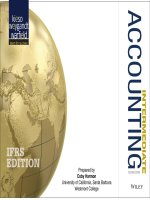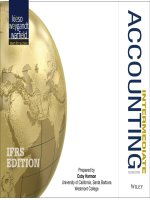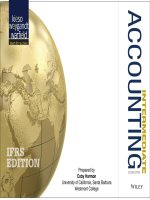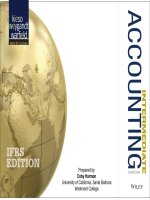Lecture Intermediate Accounting (13th edition) - Chapter 19: Accounting for income taxes
Bạn đang xem bản rút gọn của tài liệu. Xem và tải ngay bản đầy đủ của tài liệu tại đây (1.49 MB, 74 trang )
Chapter
19-1
CHAPTER
19
ACCOUNTING FOR INCOME TAXES
Intermediate Accounting
13th Edition
Kieso, Weygandt, and Warfield
Chapter
19-2
Learning Objectives
Learning Objectives
1.
Identify differences between pretax financial income and taxable income.
2.
Describe a temporary difference that results in future taxable amounts.
3.
Describe a temporary difference that results in future deductible amounts.
4.
Explain the purpose of a deferred tax asset valuation allowance.
5.
Describe the presentation of income tax expense in the income statement.
6.
Describe various temporary and permanent differences.
7.
Explain the effect of various tax rates and tax rate changes on deferred income taxes.
8.
Apply accounting procedures for a loss carryback and a loss carryforward.
9.
Describe the presentation of deferred income taxes in financial statements.
10.
Indicate the basic principles of the assetliability method.
Chapter
19-3
Accounting for Income Taxes
Accounting for Income Taxes
Fundamentals of
Accounting for
Income Taxes
Future taxable
amounts and
deferred taxes
Future deductible
amounts and
deferred taxes
Income
statement
presentation
Specific
differences
Rate
considerations
Chapter
19-4
Accounting for
Net Operating
Losses
Financial
Statement
Presentation
Loss carryback
Loss
carryforward
Loss carryback
example
Loss
carryforward
example
Balance sheet
Income
statement
Uncertain tax
positions
Review of AssetLiability Method
Fundamentals of Accounting for Income Taxes
Fundamentals of Accounting for Income Taxes
Corporations must file income tax returns following the guidelines
developed by the Internal Revenue Service (IRS), thus they:
calculate taxes payable based upon IRS code,
calculate income tax expense based upon GAAP.
Amount reported as tax expense will often differ from the amount of
taxes payable to the IRS.
Chapter
19-5
LO 1 Identify differences between pretax financial income and taxable income.
Fundamentals of Accounting for Income Taxes
Fundamentals of Accounting for Income Taxes
Financial Statements
Tax Return
Illustration 191
vs.
Exchanges
Investors and Creditors
Chapter
19-6
Pretax Financial Income
Taxable Income
GAAP
Income Tax Expense
Tax Code
Income Tax Payable
LO 1 Identify differences between pretax financial income and taxable income.
Fundamentals of Accounting for Income Taxes
Fundamentals of Accounting for Income Taxes
Illustration: KRC, Inc. reported revenues of $130,000 and expenses of
$60,000 in each of its first three years of operations. For tax purposes,
KRC reported the same expenses to the IRS in each of the years. KRC
reported taxable revenues of $100,000 in 2010, $150,000 in 2011, and
$140,000 in 2012. What is the effect on the accounts of reporting
different amounts of revenue for GAAP versus tax?
Chapter
19-7
LO 1 Identify differences between pretax financial income and taxable income.
Book vs. Tax Difference
Book vs. Tax Difference
GAAP
GAAPReporting
Reporting
Illustration 192
2010
2011
2012
Total
Revenues
$130,000
$130,000
$130,000
$390,000
Expenses
60,000
60,000
60,000
180,000
Pretax financial income
$70,000
$70,000
$70,000
$210,000
Income tax expense (40%)
$28,000
$28,000
$28,000
$84,000
Illustration 193
Tax
TaxReporting
Reporting
2010
2011
2012
Total
Revenues
$100,000
$150,000
$140,000
$390,000
Expenses
60,000
60,000
60,000
180,000
Pretax financial income
$40,000
$90,000
$80,000
$210,000
Income tax payable (40%)
$16,000
$36,000
$32,000
$84,000
Chapter
19-8
LO 1 Identify differences between pretax financial income and taxable income.
Book vs. Tax Difference
Book vs. Tax Difference
Illustration 194
Comparison
Comparison
2010
Income tax expense (GAAP)
Income tax payable (IRS)
Difference
2011
2012
$28,000
$28,000
$28,000
$84,000
16,000
36,000
32,000
84,000
$12,000
$(8,000)
$(4,000)
Are the differences accounted for in the financial statements?
Year
Reporting Requirement
2010
Deferred tax liability account increased to $12,000
2011
Deferred tax liability account reduced by $8,000
2012
Deferred tax liability account reduced by $4,000
Chapter
19-9
Total
$0
Yes
LO 1 Identify differences between pretax financial income and taxable income.
Financial Reporting for 2010
Financial Reporting for 2010
Balance Sheet
Assets:
Income Statement
2010
Revenues:
2010
Expenses:
Liabilities:
Deferred taxes
Income tax payable
Equity:
12,000
16,000
Income tax expense
28,000
Net income (loss)
Where does the “deferred tax liability” get reported in the financial statements?
Chapter
19-10
LO 1 Identify differences between pretax financial income and taxable income.
Temporary Differences
Temporary Differences
A Temporary Difference is the difference between the tax basis of an asset or
liability and its reported (carrying or book) amount in the financial statements that
will result in taxable amounts or deductible amounts in future years.
Future Taxable Amounts
Future Deductible Amounts
Deferred Tax Liability represents the
increase in taxes payable in future years as a
result of taxable temporary differences
existing at the end of the current year.
Deferred Tax Asset represents the increase
in taxes refundable (or saved) in future years
as a result of deductible temporary differences
existing at the end of the current year.
Illustration 1922 Examples of Temporary Differences
Chapter
19-11
LO 2 Describe a temporary difference that results in future taxable amounts.
Future Taxable Amounts and Deferred Taxes
Future Taxable Amounts and Deferred Taxes
Illustration: In KRC’s situation, the only difference between the book basis
and tax basis of the assets and liabilities relates to accounts receivable that arose
from revenue recognized for book purposes. KRC reports accounts receivable at
$30,000 in the December 31, 2010, GAAPbasis balance sheet. However, the
receivables have a zero tax basis.
Illustration 195
Chapter
19-12
LO 2 Describe a temporary difference that results in future taxable amounts.
Future Taxable Amounts and Deferred Taxes
Future Taxable Amounts and Deferred Taxes
Illustration: Reversal of Temporary Difference, KRC Inc.
Illustration 196
KRC assumes that it will collect the accounts receivable and report the $30,000 collection
as taxable revenues in future tax returns. KRC does this by recording a deferred tax
liability.
Chapter
19-13
LO 2 Describe a temporary difference that results in future taxable amounts.
Future Taxable Amounts and Deferred Taxes
Future Taxable Amounts and Deferred Taxes
Deferred Tax Liability
A deferred tax liability represents the increase in taxes payable in future years
as a result of taxable temporary differences existing at the end of the current year.
Illustration 194
2010
Income tax expense (GAAP)
Income tax payable (IRS)
Difference
Chapter
19-14
2011
2012
Total
$28,000
$28,000
$28,000
$84,000
16,000
36,000
32,000
84,000
$12,000
$(8,000)
$(4,000)
$0
LO 2 Describe a temporary difference that results in future taxable amounts.
Future Taxable Amounts and Deferred Taxes
Future Taxable Amounts and Deferred Taxes
Deferred Tax Liability
Illustration: Because it is the first year of operations for KRC, there is no
deferred tax liability at the beginning of the year. KRC computes the income tax
expense for 2010 as follows:
Illustration 199
Chapter
19-15
LO 2 Describe a temporary difference that results in future taxable amounts.
Future Taxable Amounts and Deferred Taxes
Future Taxable Amounts and Deferred Taxes
Deferred Tax Liability
Illustration: KRC makes the following entry at the end of 2010 to record
income taxes.
Income Tax Expense
Chapter
19-16
28,000
Income Tax Payable
16,000
Deferred Tax Liability
12,000
LO 2 Describe a temporary difference that results in future taxable amounts.
Future Taxable Amounts and Deferred Taxes
Future Taxable Amounts and Deferred Taxes
Deferred Tax Liability
Illustration: Computation of Income Tax Expense for 2011.
Illustration 1910
Chapter
19-17
LO 2 Describe a temporary difference that results in future taxable amounts.
Future Taxable Amounts and Deferred Taxes
Future Taxable Amounts and Deferred Taxes
Deferred Tax Liability
Illustration: KRC makes the following entry at the end of 2011 to record
income taxes.
Income Tax Expense
Deferred Tax Liability
Income Tax Payable
Chapter
19-18
28,000
8,000
36,000
LO 2 Describe a temporary difference that results in future taxable amounts.
Future Taxable Amounts and Deferred Taxes
Future Taxable Amounts and Deferred Taxes
Deferred Tax Liability
Illustration: The entry to record income taxes at the end of 2012 reduces the
Deferred Tax Liability by $4,000. The Deferred Tax Liability account appears as
follows at the end of 2012.
Illustration 1911
Chapter
19-19
LO 2 Describe a temporary difference that results in future taxable amounts.
Future Taxable Amounts and Deferred Taxes
Future Taxable Amounts and Deferred Taxes
E191: Starfleet Corporation has one temporary difference at the end of 2010
that will reverse and cause taxable amounts of $55,000 in 2011, $60,000 in 2012,
and $75,000 in 2013. Starfleet’s pretax financial income for 2010 is $400,000,
and the tax rate is 30% for all years. There are no deferred taxes at the beginning
of 2010.
Instructions
a) Compute taxable income and income taxes payable for 2010.
b) Prepare the journal entry to record income tax expense, deferred income taxes,
and income taxes payable for 2010.
Chapter
19-20
LO 2 Describe a temporary difference that results in future taxable amounts.
Future Taxable Amounts and Deferred Taxes
Future Taxable Amounts and Deferred Taxes
Ex . 1 9 1 :
Cur r e nt Y r .
I NCO ME:
2010
2011
2012
2013
Fina nc ia l inc o m e ( GA A P)
4 0 0 , 0 0 0
T e m po r a r y Dif f .
(1 9 0 , 0 0 0 )
5 5 , 0 0 0
6 0 , 0 0 0
7 5 , 0 0 0
a. 2 1 0 , 0 0 0
30%
5 5 , 0 0 0
6 0 , 0 0 0
7 5 , 0 0 0
a. 6 3 , 0 0 0
1 6 , 5 0 0
T a x a b le inc o m e ( I RS )
T ax r ate
I nc o m e t a x
b.
Chapter
19-21
I nc o m e t a x e x pe ns e ( plug )
30%
30%
1 8 , 0 0 0
30%
2 2 , 5 0 0
1 2 0 , 0 0 0
I nc o m e t a x pa y a b le
6 3 , 0 0 0
De f e r r e d t a x lia b ilit y
5 7 , 0 0 0
LO 2 Describe a temporary difference that results in future taxable amounts.
Future Deductible Amounts and Deferred Taxes
Future Deductible Amounts and Deferred Taxes
Illustration: During 2010, Cunningham Inc. estimated its warranty costs
related to the sale of microwave ovens to be $500,000, paid evenly over the next
two years. For book purposes, in 2010 Cunningham reported warranty expense
and a related estimated liability for warranties of $500,000 in its financial
statements. For tax purposes, the warranty tax deduction is not allowed until
paid.
Illustration 1912
Chapter
19-22
LO 3 Describe a temporary difference that results in future deductible amounts.
Future Deductible Amounts and Deferred Taxes
Future Deductible Amounts and Deferred Taxes
Illustration: Reversal of Temporary Difference, Cunningham Inc.
Illustration 1913
When Cunningham pays the warranty liability, it reports an expense (deductible amount)
for tax purposes. Cunningham reports this future tax benefit in the December 31, 2010,
balance sheet as a deferred tax asset.
Chapter
19-23
LO 3 Describe a temporary difference that results in future deductible amounts.
Future Deductible Amounts and Deferred Taxes
Future Deductible Amounts and Deferred Taxes
Deferred Tax Asset
A deferred tax asset represents the increase in taxes refundable (or saved) in
future years as a result of deductible temporary differences existing at the end of
the current year.
Chapter
19-24
LO 3 Describe a temporary difference that results in future deductible amounts.
Future Deductible Amounts and Deferred Taxes
Future Deductible Amounts and Deferred Taxes
Deferred Tax Asset
Illustration: Hunt Co. accrues a loss and a related liability of $50,000 in 2010
for financial reporting purposes because of pending litigation. Hunt cannot
deduct this amount for tax purposes until the period it pays the liability, expected
in 2011.
Illustration 1914
Chapter
19-25
LO 3 Describe a temporary difference that results in future deductible amounts.









